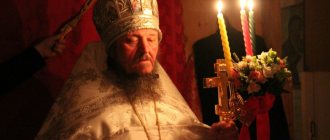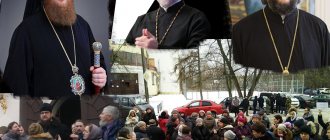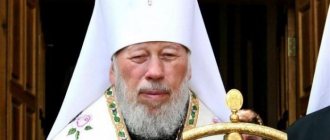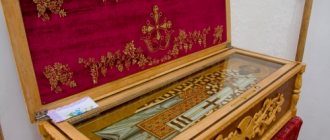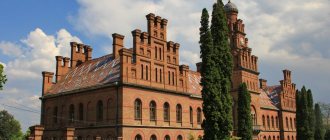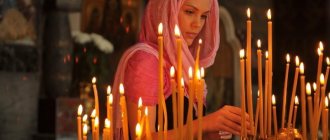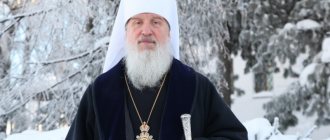| Metropolitan Nifont (Malt) |
Niphon (Malk)
(1948 - 2017), Metropolitan b. Volynsky and Lutsky, rector of the Lutsk Intercession Cathedral In the world, Vasily Andreevich Solodukha, was born on October 5, 1948 in the village of Galina Volya, Starovyzhevsky district, Volyn region of Ukraine, into a peasant family.
At the age of two he was left an orphan.
In 1963 he graduated from a local eight-year school.
From 1963 to 1967 he worked on a collective farm.
In 1967-1969 he served in the ranks of the Soviet army.
In 1969-1970 he worked at the railway depot of the city of Brest.
In 1970 he entered the Moscow Theological Seminary.
In 1971-1974 he was a subdeacon of the Patriarch of Moscow and All Rus' Pimen.
On March 20, 1974, he was tonsured a monk at the Trinity-Sergius Lavra with the name Nifont.
On April 15 of the same year, he was ordained to the rank of hierodeacon in the Epiphany Cathedral in Elokhov, Moscow, by Patriarch Pimen of Moscow and All Rus'.
In 1974 he graduated from the Moscow Theological Seminary and in the same year entered the Moscow Theological Academy, from which he graduated in 1979 with a candidate of theology degree.
On February 26, 1977, he was ordained to the rank of hieromonk in the Intercession Academic Church of the Trinity-Sergius Lavra by the rector of the MDAiS, Archbishop Vladimir (Sabodan) of Dmitrov and sent to serve in the Volyn diocese.
On March 18, 1977, he was appointed rector of the Trinity Church in the village of Rudka Kozinskaya, Rozhishchensky district, Volyn region.
In 1985 he was elevated to the rank of abbot.
In 1988, he was elevated to the rank of archimandrite by Archbishop of Volyn and Rivne Varlaam (Ilyushchenko).
In 1989, he was appointed dean of the Rozhishchensky district of the Volyn-Rivne diocese.
On March 20, 1990, he was determined to be the Bishop of Khmelnitsky and Kamenets-Podolsk. On March 30 he was named, and on March 31 he was consecrated Bishop of Khmelnitsky and Kamenets-Podolsk in the Vladimir Cathedral in Kiev.
On August 25, 1992, he was transferred to the Volyn department due to the difficult interfaith situation in the city of Lutsk.
On July 28, 1993, he was elevated to the rank of archbishop.
On April 11, 2001 he was elevated to the rank of metropolitan.
From July 13, 2006 to February 26, 2010, he was the acting rector of the Volyn Theological Seminary [1].
Since July 20, 2012, it was titled Volyn and Lutsk [2].
On October 18, 2021, he was released from the administration of the diocese due to health reasons, with a stay in the city of Lutsk and appointment as rector of the Lutsk Intercession Cathedral [3].
He died at four o'clock in the morning on March 22, 2021, at the age of 69.
NIFONT (MALT)
In the world of Solodukha, Vasily Andreevich, was born on October 5, 1948 in the village of Galina Volya, Starovyzhevsky district, Volyn region of Ukraine, into a peasant family.
At the age of two he was left an orphan.
In 1963 he graduated from a local eight-year school.
From 1963 to 1967 he worked on a collective farm.
In 1967-1969 he served in the ranks of the Soviet army.
In 1969-1970 he worked at the railway depot of the city of Brest.
In 1971-1974 he was a subdeacon of the Patriarch of Moscow and All Rus' Pimen.
On March 20, 1974, he was tonsured a monk at the Trinity-Sergius Lavra with the name Nifont.
On April 15 of the same year, he was ordained to the rank of hierodeacon in the Epiphany Cathedral in Elokhov, Moscow, by Patriarch Pimen of Moscow and All Rus'.
In 1974 he graduated from the Moscow Theological Seminary and in the same year entered the Moscow Theological Academy, from which he graduated in 1979 with a candidate of theology degree.
On February 26, 1977, he was ordained to the rank of hieromonk in the Intercession Academic Church of the Trinity-Sergius Lavra by the rector of the MDAiS, Archbishop Vladimir (Sabodan) of Dmitrov and sent to serve in the Volyn diocese.
On March 18, 1977, he was appointed rector of the Trinity Church in the village of Rudka Kozinskaya, Rozhishchensky district, Volyn region.
In 1985 he was elevated to the rank of abbot.
In 1988, he was elevated to the rank of archimandrite by Archbishop of Volyn and Rivne Varlaam (Ilyushchenko).
On March 20, 1990, he was determined to be the Bishop of Khmelnitsky and Kamenets-Podolsk. On March 30 he was named, and on March 31 he was consecrated Bishop of Khmelnitsky and Kamenets-Podolsk in the Vladimir Cathedral in Kiev.
On August 25, 1992, he was transferred to the Volyn department due to the difficult interfaith situation in the city of Lutsk.
On July 28, 1993, he was elevated to the rank of archbishop.
On April 11, 2001 he was elevated to the rank of metropolitan.
From July 13, 2006 to February 26, 2010, he was the acting rector of the Volyn Theological Seminary [1].
Since July 20, 2012, it was titled Volyn and Lutsk [2].
On October 18, 2021, he was released from the administration of the diocese due to health reasons, with a stay in the city of Lutsk and appointment as rector of the Lutsk Intercession Cathedral [3].
He died at four o'clock in the morning on March 22, 2021, at the age of 69.
Metropolitan Nifont: it was a real confession
— In 1992, when Filaret fell away from the united Russian Church and established a different altar, he caused a schism throughout Ukraine. In particular, this greatly affected Western Ukraine. I myself come from the Volyn region. In 1990, I was ordained a bishop and sent to the city of Khmelnytsky. I stayed there for two years and five months. In 1992, nationalists, Rukhovtsy and other nationalist parties, who demanded their own church, expelled the then Bishop Bartholomew from the Holy Trinity Cathedral in the city of Lutsk. They captured not only the cathedral, but also the diocesan administration, and all six buildings of the Volyn Theological Seminary. Then, on the advice of Bishop Bartholomew, our synod moved me, a good-for-nothing, from the city of Khmelnytsky to the city of Lutsk. On the one hand, it was very joyful for me, because I was returning to my native land, but on the other hand, it was very scary, because everything in Lutsk had already been captured by schismatics. I arrived at the end of August 1992 in Lutsk. The cathedral had already been captured, other churches were captured, only one Church of the Intercession remained, in which I still serve as the cathedral. I had nowhere to live, I lived in private apartments. They didn’t want to register me because they called me a “Moscow priest.” And then only at the end of 1993, when I complained to the regional authorities that I would complain to the United Nations that I, a Ukrainian, a Volynian by birth, was not registered in the city of Lutsk, where I did not come arbitrarily, but was sent as a ruling bishop, - then the two-story parish house at the Church of the Intercession was given under diocesan administration, and the ancient building of the Catholic Dominican monastery on Drahomanov Street was given to the seminary. On January 24, 1994, I registered as a resident of the city of Lutsk. Filaret’s men seized churches brutally – with beatings. Two priests died, many had their arms broken, fingers and teeth knocked out, people were injured on the head with iron sticks, and many ended up in intensive care. It was scary. But people, as confessors, preserved the unity of the Orthodox Church and faith. In the fall of 1992, the Church of the Intercession was also sealed. We prayed on the street, but people did not back down. There was a time when we prayed in the courtyard of the temple, cordoned off by the police, and around the fence there was an angry crowd, which all the time chanted: “Nifonta quarter, Nifonta quarter!”, “Get the Moscow drinks, get the Moscow drinks!” We prayed with faith at the temple, and sometimes I joked like this: “Here, brothers and sisters, behind the fence the brothers pray and we pray. Who do you think the Lord hears more?” There was a moment in the fall of 1992 when representatives of the city authorities came and demanded that we leave the courtyard of the Intercession Church. Then several dozen elderly women came forward and said: Take machine guns and shoot us, take shovels and bury us near the Church of the Intercession.” This was a real confession. Throughout the diocese, a large number of churches were taken away by violence, bribery, and blackmail, but the people survived. In many villages, people began to build their own temporary temples, then they built good, standard temples. We filed a lawsuit to have the Trinity Cathedral returned to us. The Ukrainian Republican Court, which sat in the city of Khmelnitsky, ruled on February 4, 1994 that the order of the regional administration and the city of Lutsk (on the transfer of the cathedral to the Filaretites) was invalid - all state and architectural laws had been violated, and everything must be returned to the rightful owner. Of course, there was a crowd all the time near the cathedral, where Filaret’s bishop, Metropolitan John Bodnarchuk, served, who to a large extent caused the schism in Ukraine. And I remember how in February 1994 there was a meeting on the steps of the Trinity Cathedral - there was this “metropolitan” in a white hood, there were so-called priests, and there was a crowd of people with bloodshot, embittered eyes. Among them was one person, Yantsukevich Pyotr Nikolaevich, the son of a priest, who, translated into Russian, said with terrible anger something like this: “We heard that the Khmelnytsky court decided to give our cathedral to the Muscovites. Let them come here and we will smash their brains all over the pillars. They will wash themselves with their own blood and wipe their own snot.” Of course, after such a request, there was no way I could organize people to seize the cathedral - that would only be worse for us. And here, as the Holy Scripture says, only prayer and patience will help. We prayed on the street. And if in 1992-93 we had only one Church of the Intercession, today in Lutsk we have 20 Divine Liturgies on Sunday. This is both joyful and comforting. This strengthens believers. Of course, not all of these are temples; there are adapted premises. But where we were given plots to build temples, we build. They have already built and consecrated the Ilyinsky Church, the Peter and Paul Church on Rivne Street, I recently consecrated the Exaltation of the Cross in the Teremno area, the Trekhsvyatitelsky Church on Dubinskaya Street and other churches are about to be consecrated. With great difficulty, in 1993 we managed to obtain a plot of land in an area where there are many nine-story buildings, and in 1998 we founded the Church of All Saints of the Volyn Land there. In 1993, the miraculous Pochaev Icon of the Mother of God was in our diocese, we carried it around all the cities - regional centers and almost all villages. Thanks to this religious procession, we then collected a pretty penny and bought the so-called “module”. We placed it there and already on October 23, the day of All Saints of the Volyn Land, we served there. In 1994, I consecrated this “module”. Those who consider themselves to be part of the so-called Kyiv Patriarchate said: “Look how cunning Nifont is: he built a greenhouse and in that greenhouse he raises Muscovites.” And in the winter, when it was very cold there for the first two years, they said: “You see, what a cunning Muscovite: he keeps a refrigerator in the winter and preserves Muscovites for longer, you parasite!” And then the Lord managed to call it “Noah’s Ark.” And believe me: every Sunday, especially when the bishop is serving, up to five to seven thousand people gather there. And on the Feast of All Saints of the Volyn Land there is a very large pilgrimage - up to 10 thousand people pray. It was all very difficult - with sweat, blood, tears, confession and the titanic patience of the clergy and the believing people. Today we have one problem: our mayor has not allowed our two communities to build churches for four years in a row. It would be possible, of course, to take some steps - strikes, religious processions, some kind of standing. But that wouldn't help us. We just endure and pray, pray and endure. And I urge believers to build what remains only with patience and prayer. Today, the Volyn region was divided in 1996 into two dioceses: there is the Lutsk diocese - 8 districts of the region, and the Vladimir-Volyn diocese - also 8 districts of the region. I now have 359 communities and 308 priests. Bishop Nikodim, Bishop of Vladimir-Volyn and Kovel, has about 260 communities. That is, there are more than 600 communities in the region. In my diocese there are also three monasteries - two for women and one for men, and the Volyn Theological Seminary, where last year 120 people studied - 90 boys and 30 girls in the regency courses. Bishop Nikodim has 4 monasteries. Thank God that our people are good believers, we have a good people, and Holy Orthodoxy rests on it. These days, when His Holiness visited Ukraine and, by God's Providence, he did not bypass our Volyn land and the western regions. Yesterday, while visiting us near the cathedral under construction and in our temporary church, His Holiness saw the believing people, the clergy, and the youth, who met their patriarch with sincere and genuine faith, like a child. And they chanted “Our Patriarch Kirill!”, and prayed with tears, and sang the Volyn many years to His Holiness, and so sincerely said to His Holiness “God bless you” that he even shuddered - I noticed it. When His Holiness left, our people stood and greeted each other with the Easter greeting “Christ is Risen! “Truly He is Risen!” We only had such an upsurge of spirit in 1993, when we had the Pochaev Icon of the Mother of God, when miraculous icons were brought from the Orenburg region and from Kyiv, and now, when His Holiness arrived. I am very grateful to God for his providence and very grateful to His Holiness for his fatherly visit, for his deeply meaningful words and for his holy prayers. — How many communities of the Kyiv Patriarchate are there in the region? — They give on paper 200-240 communities. But they actually have 120-140 active communities, and there are no more. Those areas adjacent to Belarus are calmer. Those adjacent to Galicia are less calm. A few years ago, apparently, they had an order from Kyiv, and they opened churches in all regional centers, even in those where there were none. — Vladyka, how do you see the future of Orthodoxy in Ukraine? “Son, if politicians, various parties and state administrators and deputies had not interfered, the split would have died out on its own a long time ago.” And so they are heated. For example, the mayor signed permission for a picket at the place where His Holiness the Patriarch will arrive, four days before this event. But, thank God, everything went well for us. — Now, traveling around Western Ukraine, I noticed that in almost every city and large village there are noticeable, recently built Protestant houses of prayer. In your opinion, is this growth of Protestantism in Ukraine connected with division among the Orthodox? — Protestant communities appeared in Volyn after 1945. They supported the Soviet Union. Baptists, Pentecostals and Seventh-day Adventists. But like all religions, they were oppressed. And now, when they were given freedom, they developed. Moreover, they are financed by America. Wherever they have fifty people, they are already building a house of worship. They don’t collect money here – neither from benefactors, nor from patrons. And it is very difficult for the believers of our church. Of course, the schism contributes to the growth of Protestant movements. Believers see this disgrace when priests fight against priests, when blood is shed. And Protestant preachers do not miss the opportunity to say: “You see, these same priests crucified Christ, and they also baptize incorrectly in childhood.” There are people who do not know the interpretation of the Holy Scriptures and who accept this false teaching. But already now, in many of my parishes, priests who even graduated from the Volyn Theological Seminary and ordained by me are organizing Sunday school in almost every village. And there are children who go to Protestant houses of worship, but these are mostly Protestant children. Our children don’t go there like they used to. Of course, if all our priests are at their best, if there is a living sermon, deep faith and the priests live according to the Gospel, then Protestantism will diminish. If the priests chase after mammon, after luxury, after profit, then the Christianity of the Orthodox Church will be diminished, because Protestants do not sleep for a second. — Vladyka, among the slogans of the protesters were demands for prayer in their native Ukrainian language. To what extent would translating the service into Ukrainian solve the problem of schism? “Here, son, it’s not so much the language that is important as the sense of national dignity.” After all, those who go to church do not understand either Church Slavonic or Ukrainian if the music being sung is too concert-like. Among my 360 parishes, there are 60 parishes that serve, as we say, in Ukrainian. But only the Liturgy has been translated, and when it comes to other services, they are served in Church Slavonic. And much in the Liturgy is translated incorrectly. Because there are no Ukrainian words that could express the full depth of Christian Orthodox teaching, which is in the Church Slavonic language. I have been to churches where they serve in Ukrainian. It would seem that there should be a lot of people there. But that's not true. People go where there is grace, where there is a gracious priest. And those who agitate for the Kiev Patriarchate, they play on this line of nationalism - they say, this is ours, Ukrainian, not Moscow. It’s as if the Church Slavonic language is the Moscow language! After all, they don’t speak it in Moscow! They don’t speak it anywhere at all, but only in church, and even then they don’t speak it, and they read and sing while looking at books. This is the language of Cyril and Methodius, this is our root. But you can’t explain this to people whose minds are closed. — There is an opinion that if the canonical Orthodox Church became autocephalous - that is, completely separated from the Moscow Patriarchate in a canonical manner, then the schism would lose ground. What do you say to this? - It's hard to talk about this. If this had been done earlier - back in 1988, when they celebrated the 1000th anniversary of the Baptism of Rus' and when the late Metropolitan Theodosius of Poltava advised the synodals to present Ukraine with such a gift in the form of a patriarchal title for the ruling bishop in the city of Kyiv - then it would probably have been in a timely manner. And now this word “autocephaly” turns out to be connected with this split, all the lawlessness that was done in 1992 and that is being done now. You were in Lutsk and heard a handful of people shouting among a crowd of ten thousand. What were they shouting about? About autocephaly. This is shame and disgrace for the Ukrainian nation, this is bad manners, this speaks of a lack of church morality, this speaks of such anger that is ready to tear us all apart. Today, the issue of autocephaly is no longer perceived in the same way as before – even here in Volyn. So His Holiness arrived and you heard: even here the people chanted “Our Patriarch is Kirill!” Ten years ago this would not have happened! About five years ago, autocephaly would have been beneficial for us in Volyn. Now, even if autocephaly is legal, it will still give rise to a schism. Half of the parishes, even mine, will go to the Patriarch of Russia (in direct submission). It will be a canonical schism, but still a schism. Therefore, if only politicians did not interfere in the life of the Church, then the schism that exists would have been eliminated by itself.
Awards
- Order of St. Anthony and Theodosius of Kiev-Pechersk II Art. (1998, UOC)
- order of honor book Daniel of Moscow II Art. (1998)
- Order of Equals book Vladimir III Art. (1999, UOC)
- Order of the Nativity of Christ - 2000, 1st class. (2000, UOC)
- medal “Kharkov Cathedral - 10 years”, 1st degree (2002, UOC)
- Order of St. Sergius of Radonezh II Art. (2003)
- Order of Equals book Vladimir I-II centuries, with the title “Sergeant Major of the Order of St. Prince Vladimir” (2003, UOC)
- Order of St. ap. John the Evangelist II Art. (2005, in connection with the 15th anniversary of the episcopal consecration)
- Order of St. Nestor the Chronicler II Art. (2006, UOC)
- Order of St. equal to Mary Magdalene II Art. (2008, Polish Orthodox Church)
- Order of St. Cyril and Methodius I Art. (2008, Orthodox Church of the Czech Lands and Slovakia)
- Order of St. Alexy of Moscow III Art. (2008)
- Order of St. ap. John the Evangelist I Art. (2008)
- medal named after St. Cyril and Methodius I Art. (2008, Uzhgorod Theological Academy)
- scientific degree “Honorary Doctor of Theology” from the Uzhgorod Ukrainian Theological Academy named after Saints Methodius and Cyril (February 20, 2008, for significant services to the UOC and for a significant contribution to the development of theological education [4])
- Order of St. Dimitry Rostovsky (2010)
- honor of the Primate of the UOC (2011)
- Order of St. Anthony and Theodosius of Pechersk I Art. (2012)
- Order of St. Seraphim of Sarov II Art. (2013, in connection with the 65th anniversary of his birth) [5]
- right of service with two panagias (2014) [6]
- medal "For Humanism" (1997, )
- diploma winner in the nomination “Charity of the Year” in the program “Person of the Year’98” Lutsk (1998)
- Certificate of honor from the Volyn Regional Council of People's Deputies (1998, for selfless work in the spiritual revival of Volyn, active participation in organizing and conducting charity and mercy events)
- recognized as a benefactor of the year in the program “Person of the Year of the Volyn Region '99” (1999)
- Order of Merit, III class. (1999, Ukraine)
- commemorative medal of the President of Ukraine for the 10th anniversary of Ukraine's independence (2001)
- Diploma of Laureate of Regional Philanthropy and Sponsorship (2001, Volyn Regional State Administration)
- memorial sign of the Children's Fund of Ukraine “I give my heart to children” (twice: 2003 (first in Volyn), 2004)
- Order of Merit, II class. (2003, Ukraine)
- Badge "Excellent Border Guard" 1st class. (2003, command of the Volyn border detachment)
- Order of Cossack Glory, 1st class. (2003, MOO "Cossacks Zaporozhye")
- Medal "For Merit" III class. (2005, Union of Afghanistan Veterans)
- gold medal “Cossack Glory” and medal of the 10th anniversary of the MOO “Zaporozhye Cossacks” (2006)
- distinction of the Ministry of Internal Affairs of Ukraine “For assistance to the internal affairs bodies of Ukraine” (2007)
- Order of the Intercession, 1st class. (2007, Supreme Ataman of Ukraine and Diaspora)
- Order of Merit, 1st class. (2008, Ukraine)
- honorary insignia of the Department of the Ministry of Internal Affairs of Ukraine in the Volyn region (2008)
- Order "Hetman Baida - Vishnevetsky" 1st class. (2008, MOO "Cossacks Zaporizhzhya")
Biography
Born into a peasant family [1].
The parents of the future metropolitan died when he was in infancy, the child was raised by his grandmother, a deeply religious believer [2], and after her death by his aunt [3]. In 1963 he graduated from eight-year school. During 1963-1967 he worked on a collective farm, from 1967 to 1969 he served in the Soviet army in Novgorod the Great [2]. In 1969-1970 he worked at the railway depot of the city of Brest [1].
From 1970 to 1974 he studied at the Moscow Theological Seminary. While studying at the seminary, he was a subdeacon with the Patriarch of Moscow and All Rus' Pimen [2]. The student’s confessor was John (Maslov) [2]. On March 20, 1974, he took monastic vows with the name Nifont
in honor of Saint Nifont, Bishop of Novgorod, miracle worker of Kiev-Pechersk [1]. In 1974 he received the rank of hierodeacon [1]. In the same year he was enrolled in the Moscow Theological Academy, from which he graduated in 1979 [4].
In 1977, he was ordained as a hieromonk and sent to serve in the Volyn diocese [1]. On March 18, 1977, he was appointed rector of the Trinity Church in the village of Rudka Kozinskaya, Volyn region [1].
In 1988 he was elevated to the rank of archimandrite, and in 1989 he was appointed dean of the Rzhishchev district of the Vladimir-Volyn diocese [1].
In 1990, Khmelnitsky was separated from the Vinnytsia diocese. On March 31, 1990, the episcopal consecration of Archimandrite Nifont as Bishop of Khmelnitsky and Kamenets-Podolsk took place [1]. During two years of service, the bishop consecrated more than two hundred churches [5].
On August 25, 1992, Nifont was transferred to the Volyn department [1]. At this time, all the churches of Lutsk, except for the Holy Intercession Church, were occupied by supporters of the “Kyiv Patriarchate” [6], the Holy Trinity Cathedral, the diocesan administration and the premises of the Volyn Theological Seminary were seized [6]. Despite the attacks [6] [3] by members of "Rukh" [6] [3] [7] and supporters of the Kiev Patriarchate [6] [3] [7] on the Holy Protection Church and the Volyn Seminary [6] [3] [7], the bishop managed to provide training for students; by 2005, 18 communities of the UOC were already operating in Lutsk [3], by 2006, Metropolitan Nifont ordained more than three hundred clergy [6]. A year and a half after Nifont’s appointment to Lutsk, local authorities refused the bishop registration in this city [5] [7], calling Bishop Nifont, a native Volynian, a “Moscow priest” [7].
Metropolitan Nifont (Malt) reposed in the Lord
Lutsk, March 24, 2021
Since 1992, for 24 years, Bishop Nifont was the ruling bishop of the Volyn diocese; since October 22, 2021, he has been retired for health reasons.
The location of the funeral service and burial of Metropolitan Nifont will be announced later. By order of Bishop Nathaniel of Volyn and Lutsk, the priests of the diocese are blessed to perform funeral services for the newly deceased bishop.
Metropolitan Nifont (in the world Vasily Andreevich Solodukha) was born on October 5, 1948 in the village. Galina Volya, Starovyzhevsky district, Volyn region. Ukraine in a peasant family. After graduating from eight-year school in 1963, he worked on a collective farm. In 1967-1969. served in the ranks of the Soviet army, then worked at the railway depot in Brest.
In 1970 he entered the Moscow Theological Seminary.
Since 1971, he served as subdeacon Patriarch Pimen (Izvekov).
On March 20, 1974, at the Trinity-Sergius Lavra, he was tonsured a monk, and on April 15, he was ordained a hierodeacon.
In 1974 he entered the Moscow Theological Academy, from which he graduated in 1979 with a candidate's degree in theology.
On February 26, 1977, he was ordained hieromonk and sent to serve in the Volyn diocese.
On March 18, 1977, he was appointed rector of the Trinity Church in the village. Rudka Kozinskaya, Rozhishchensky district, Volyn region.
In 1985 he was elevated to the rank of abbot, in 1988 to the rank of archimandrite.
In 1989, he was appointed dean of the Rozhishchensky district of the Volyn-Rivne diocese.
By the decision of the Synod of the Ukrainian Orthodox Church on March 20, 1990, he was elected Bishop of Khmelnytsky and Kamenets-Podilsky. Consecrated on March 31 at the Divine Liturgy in the Vladimir Cathedral in Kyiv.
On August 25, 1992 he was transferred to the Volyn department.
On July 28, 1993, he was elevated to the rank of archbishop, and on April 11, 2001, to the rank of metropolitan.
Since July 20, 2012 - Metropolitan of Volyn and Lutsk.
By the decision of the Synod of the Ukrainian Orthodox Church of October 18, 2016 (magazine No. 42), he was released from the administration of the Volyn diocese for health reasons and appointed rector of the Intercession Cathedral in Lutsk.
Notes
- ↑ 1234567891011
Bishops of Khmelnytsky and Kamenets-Podilsky Varlaam (Borisevich) (1955-1956) • Hilarion (Kochergin) (1956-1961) • Ignatius (Demchenko) (1961-1962) • Feodosius (Dikun) (1990) • Nifont (Solodukha) (1990-1992) • Pitirim ( Starinsky) (1992-1993) Bishops of Kamenets-Podolsk and Proskuriv Pankratiy (Kashperuk) (1946-1948) • Varlaam (Borisevich) (1948-1951) • Anatoly (Busel) (1951-1953) • Andrey (Sukhenko) (1953-1955, high school) Bishops of Proskurov Valerian (Rudich) (1921-1923) • Dimitri (Galitsky) (1927-1932) Ruling Augustine (Markevich) · Agapit (Bevtsik) · Agafangel (Savvin) · Alexy (Grokha) · Alexy (Shpakov) · Alipy (Kozoliy) · Ambrose (Polykope) · Anatoly (Gladky) · Anthony (Pakanich) · Anthony (Fialko) · Bogolep (Goncharenko) · Bartholomew (Vashchuk) · Vissarion (Stretovich) · Vladimir (Melnik) · Vladimir (Orachev) · Evlogiy (Gutchenko) · Eusebius (Dudka) · Elisha (Ivanov) · Efrem (Kitsai) · Efrem (Yarinko) · Hilarion (Shukalo) · John (Siopko) · Joasaph (Guben) · Jonathan (Eletskikh) · Joseph (Maslennikov) · Irenaeus (Semko) · Irineus (Sredny) · Lazarus (Shvets) · Luke (Kovalenko) · Mark (Petrovtsy) · Meletiy (Egorenko) · Mitrofan (Nikitin) · Mitrofan (Yurchuk) · Nathanael (Krikota) · Nikodim (Baranovsky) · Nikodim (Gorenko) · Nikolai (Kapustin) · Onufriy (Legky) · Panteleimon (Lugovoy) · Panteleimon (Povoroznyuk) · Pitirim (Starinsky) Platon (Udovenko) Roman (Kimovich) Sergius (Gensitsky) Simeon (Shostatsky) Sophrony (Dmitruk) Tikhon (Chizhevsky) Feodor (Gayun) Feodor (Mamasuev) Filaret (Zverev) Filaret (Kucherov) Philip (Osadchenko) Vicars Alexander (Drabinko) · Alexander (Nesterchuk) · Alypiy (Pogrebnyak) · Anthony (Borovik) · Anthony (Kripak) · Arkady (Taranov) · Arseny (Yakovenko) · Varnava (Filatov) · Varsonofy (Vinnichenko) · Varsonofy (Stolyar) · Veniamin (Pogrebnoy) · Victor (Bykov) · Vladimir (Moroz) · Damian (Davydov) · Diodorus (Vasilchuk) · Evlogiy (Kid) · Ilariy (Shishkovsky) · John (Vakhnyuk) · Jonah (Cherepanov) · Cassian (Shostak) · Clement (Evenings) Longinus (Heat) Nikolai (Grokh) Nikolai (Postal) Pavel (Swan) Panteleimon (Bashchuk) Seraphim (Demyaniv) Sergius (Zaliznitsky) Sergius (Mikhailenko) Feodosius (Snigiryov) At rest Vasily (Zlatolinsky) · Gury (Kuzmenko) · Dionysius (Konstantinov) · Innokenty (Shestopal) · Ioannikiy (Kobzev) · Hippolytus (Khilko) · Niphont ( Maloduha) · Panteleimon (Romanovsky) Former bishops
*Translated Anthony (Moskalenko) · Gleb (Savin) · Job (Smakouz) · Job (Tyvonyuk) · Nektary (Frolov) Defrocked Filaret (Denisenko) · Andrey (Gorak) · Jacob (Panchuk) Deceased Anthony (Vakarik) · Vasily (Vasiltsev) · Vladimir (Sabodan) · Evfimy (Shutak) · Kronid (Mishchenko) · Leonty (Gudimov) · Macarius (Svistun) · Methodius (Petrovtsy) · Nikanor (Yukhimyuk) · Nikodim (Rusnak) · Savva (Babinets) · Sevastian (Pilipchuk) · Tikhon (Zhilyakov) · Feodosius (Dikun) - Since the transformation of the Ukrainian Exarchate of the Moscow Patriarchate into the Ukrainian Orthodox Church (Moscow Patriarchate) in October 1990.
Saint Niphon II, Patriarch of Constantinople
Saint Niphon was born around 1435-1440 in the Peloponnese (Greece), into a very pious family. Upon completion of his education, he became a monk in Epidavrion. After the death of his elder Anthony, he retired to Holy Mount Athos, where he labored in the monasteries of Koutlumousiou, Great Lavra and Dionysiou.
For his holy life, learning and eloquence, the Athonite monks forced him to instruct them, although the humble Niphon refused, saying that “he is not worthy to treat the healthy, but he himself needs to be cured of them.” After the death of Metropolitan of Thessalonica in 1483, the clergy and flock of the diocese chose Niphon as their shepherd and he, convinced by the monastic brethren and the abbot, agreed to accept the bishopric. Soon, at the end of 1486, at the insistence of the Vlachian princess, he was elevated to the patriarchal throne of Constantinople. For two years he steered the ship of the Church, but in 1488 he was deposed and retired to live in asceticism in the monastery he founded. In the struggle for influence on the election of the patriarch, characteristic of the entire era of the Turkish yoke, the saint was again nominated to the See of Constantinople, but he stayed there for only a year, from the summer of 1497 to the summer of 1498, and was again forced to retire.
Around 1500, the Vlachian governor Radu the Great called the saint to serve as high priest in his domains. For five years Saint Niphon served as Metropolitan of Wallachia, zealously serving the Church, instructing both the prince and all people without regard for ranks and titles. Under him, two new dioceses were founded with sees in the cities of Ramnicu Valcea and Buzau.
In the spring of 1502, the saint was again, for the third time, called to the See of Constantinople, but refused, preferring to remain with the Romanian flock.
In 1505, a dispute arose between the saint and the governor. The voivode criminally allowed one of his boyars, who abandoned his wife and children, to remarry his sister. Saint Niphon, intolerant of lawlessness, left his see, predicting many misfortunes for the rebellious commander. The saint convinced his faithful disciple, the boyar Neagoe Basarab, that if he adheres to Christ’s commandments, his name will become famous throughout the Romanian land.
The saint blessed his flock with tears and, together with his disciples Macarius and Joasaph, returned to the Holy Mountain, to the Vatopedi monastery. Knowing that Macarius was eager to confess Christ through martyrdom and that this was the will of God, he blessed him and he accepted death from the Turks for his confession in Thessalonica. The saint knew the hour of his martyrdom, saying to his disciple Joasaph: “Know, my son, today your brother Macarius died a martyr’s death and joyfully ascends to heaven.”
Soon he and his disciple secretly went to the Dionysios Monastery. Here Elder Petronius once saw the saint praying at night, enveloped in divine light. Saint Niphon humbly hid his rank and performed his obediences as an ordinary monk until Saint John the Baptist appeared to the abbot in a dream and revealed the saint to him, commanding him and all the brethren to meet him with honor as patriarch.
One day the saint, boarding a ship that came to the monastery, calmed the raging sea. At other times, when the brethren asked his prayers for the sailors, the saint instructed them to fulfill the rule without laziness and to refrain from idle talk.
Finally, feeling the approach of his death, the saint gathered the brethren and fulfilled their last request, composing a prayer of permission, read at the funeral service. Having blessed his disciple Joasaph to go to Constantinople and there accept the crown of martyrdom for confessing Christ, the saint rested on August 11, 1508.
Relics and glorification
According to the prediction of the saint, the pious Nyagoe Basarab became the governor of Vlahia in 1512. Remembering his mentor, in 1515 the governor transferred the relics of Saint Niphon to his possessions, to the Dyalu monastery, where he donated a large silver ark for them.
On August 16, 1517, in the newly consecrated monastery of Curtea de Arges, Patriarch Theoliptus of Constantinople, together with the Synod of the Romanian Lands and the abbots of the Athos monasteries, performed the solemn glorification of the sanctuary of Niphon. This became the first official canonization of a saint in Romania. In the same year, the relics of the saint were returned to the Dionysiu Monastery, which was completely restored at the expense of the Romanian governors Vasile Lupu, Neagoe Basaraba and Petru Rares. This is where they remain to this day. However, in gratitude, the Athonite monks handed over the venerable head and right hand of Saint Nyagoe to Basarab, who placed them in his Argesh monastery. Here they were preserved until 1949, when they were transferred to the Metropolitan Cathedral in Craiova.
